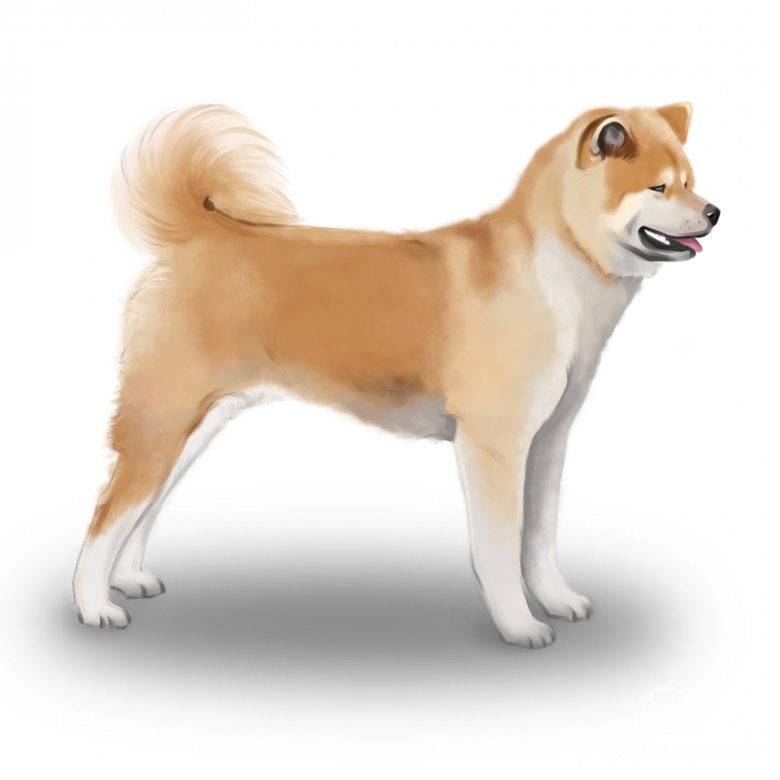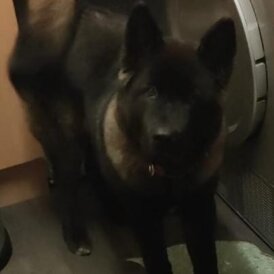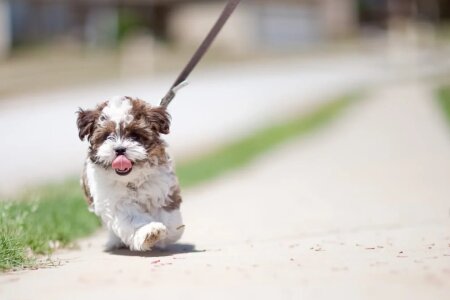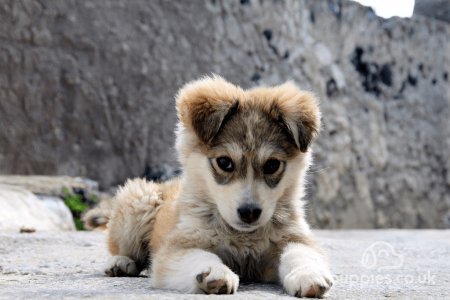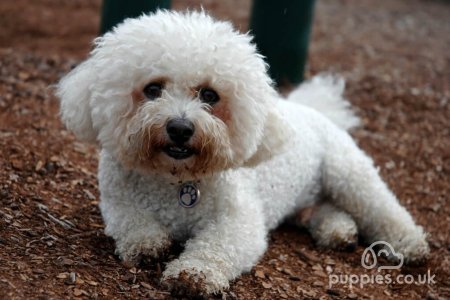Japanese Akita Inu (Akita Inu, Japanese Akita)
Overview
Perhaps the most iconic Japanese dog breed, the Japanese Akita Inu is a powerful, independent Spitz that makes for a loving companion for owners and their families. As puppies, they’re incredibly adorable and affectionate, but as they grow older and provided they’re well raised, make for a wonderfully dignified and intelligent companion.
Japanese Akita Inus should not be confused with American Akita Inus, which, outside of the United States, are widely recognised to be a different breed altogether.
Physical Appearance
The Japanese Akita Inu is a large, sturdy breed that stands noble and dignified with well-defined musculature and big bones. His head is characteristically ‘bear-like’ and his eyes are small, dark, and triangular in shape. Similarly, his ears are small and triangular, with a slight curvature around the tips. Tail is thick and set high.
Owing to their original function in cold climates as a Spitz breed, Japanese Akita Inus have a thick double coat that is harsh in texture and straight. Their coats come in many colours, including red fawn, sesame, brindle, and white. For all coat colours except white, there must be some urajiro, which is a whitish coat found on the sides of the muzzle, cheeks, and under the jaw, neck, body, chest, tail, and inner legs.
The most similar breeds to the Japanese Akita Inu are other Spitz breeds, such as the Alaskan Malamute, although they are unique enough to be readily identified.
How big do Japanese Akita Inu dogs get?
Character Traits
Japanese Akita Inus have a remarkably composed and faithful temperament, although they are quite territorial and powerful, which can lead to showing dominance. This tendency towards dominance can be problematic, particularly if he is not well-trained as a puppy. For this reason, Japanese Akita Inus are not the best choice for first-time owners.
Pet owners with experience, however, will find that their Japanese Akita Inu is a playful, loyal breed that will grow into a loving companion with proper training and socialisation.
Are Japanese Akita Inu dogs intelligent? About average.
Are Japanese Akita Inu dogs affectionate? Yes.
Do Japanese Akita Inu dogs have high or low energy levels? High energy.
Are Japanese Akita Inu dogs loyal? Yes.
Are Japanese Akita Inu dogs playful? Yes.
Are Japanese Akita Inu dogs aggressive? Yes, sometimes around dogs or strangers.
Are Japanese Akita Inu dogs easy to train? No, they are very challenging to train.
Are Japanese Akita Inu dogs good guard dogs? Yes, owing to their territorial temperament. They also make for superb watchdogs.
Ability to Socialise
Excellent socialisation is absolutely required for any prospective Japanese Akita Inu owner. Not only are they challenging to train, but the breed tends to have a naturally defensive and sometimes aggressive temperament towards others, particularly other dogs of the same sex.
Although Japanese Akita Inus tend to get along well with young children, adult friends and their owners, they may show signs of aggression towards approaching strangers. It is therefore important to socialise your puppy well and introduce friends gradually.
Around other pets, the Japanese Akita Inu may be problematic. He will most likely show dominance over other dogs and may chase small pets such as cats.
Furthermore, this breed should not be permitted to roam in off-lead areas such as parks. Always keep your Japanese Akita Inu on a lead whilst in public.
Do Japanese Akita Inu dogs get along with other pets? Somewhat.
Do Japanese Akita Inu dogs get along with other dogs? No, unless very well-trained.
Are Japanese Akita Inu dogs good with kids? Yes, very.
Are Japanese Akita Inu dogs good with strangers? No.
Lifestyle Suitability
The Japanese Akita Inu is a breed wonderfully suited to owners who live an active, outdoors lifestyle whereby they can provide them with plenty of healthy exercise. They do not suffer from separation anxiety too much and can remain alone for extended periods, but this should never become habitual.
Even as a territorial breed, Japanese Akita Inus can be adapted somewhat well to apartments and small homes, but large homes with gardens are preferable. They are therefore fairly adaptable to different environments.
Japanese Akita Inus are classified as a utility breed for bear hunting, so they are highly adaptable to cold environments and may suffer from heat due to their thick double coat.
Are Japanese Akita Inu dogs good for first-time owners? No.
Are Japanese Akita Inu dogs hypoallergenic? No.
Are Japanese Akita Inu dogs prone to drooling? Yes.
Are Japanese Akita Inu dogs a good breed for apartment living? Somewhat.
Do Japanese Akita Inu dogs shed a lot? Yes, profusely.
Do Japanese Akita Inu dogs bark a lot? No.
Can Japanese Akita Inu dogs be left alone at home? Yes, for extended periods.
Can Japanese Akita Inu dogs handle the heat? Not too well.
Can Japanese Akita Inu dogs handle cold temperatures? Yes, very well.
Are Japanese Akita Inu dogs sensitive to loud noises? No, but as puppies, loud noises should be reduced.
General Health & Health Issues
Unfortunately, the Japanese Akita Inu is not a very healthy breed. They are prone to many common autoimmune diseases, immune-mediated endocrine diseases, and other specific conditions. The good news is that many hereditary diseases can be tested for early on and treated, which emphasises the need to bring your Japanese Akita Inu into the vet’s office frequently for routine checkups.
Some common problems include:
Vogt–Koyanagi–Harada syndrome: a multisystem disease that affects skin and eyes. Can be managed, but the causes remain unknown;
Gastric dilation (bloat): bloat is a fairly common medical condition with many breeds, but adult Japanese Akita Inus are quite prone to developing bloat from a poor diet or irregular feeding;
Diabetes mellitus: type 1 diabetes which affects the pancreas. Changes to feeding may treat the symptoms, but basal insulin treatment every 12 hours are needed;
Von Willebrands disease: a fairly common blood clotting disorder caused by a deficiency of Von Willebrand factor.
How long do Japanese Akita Inu dogs live? - 11-15 years
Exercise & Play Time
Japanese Akita Inus require extensive exercise every day in order to remain tired and happy. At least two hours should be devoted, including a brisk morning walk and an afternoon or evening session of vigorous exercise. Whenever possible, ensure that he is able to play off-lead in a secure and controlled environment. In public spaces, always keep him on a lead.
Although some Japanese Akita Inus do love going for a swim, especially in hot weather to cool off, they are a large breed with a thick double coat and therefore should be carefully supervised to avoid any mishaps. As puppies, introduce them to water slowly and allow them to dip their paws in at first.
How much exercise does a Japanese Akita Inu dog need? - At least 2 hours per day
Do Japanese Akita Inu dogs like water play? Yes, but maintain supervision.
Nutrition & Feeding
As a large, high energy breed, Japanese Akita Inus require a large quantity of high-quality food in order to remain healthy. Their diet should consist of healthy proteins, vitamins, and minerals and their feeding should be split into multiple sessions.
The cost of feeding a Japanese Akita Inu can be fairly high, but it is essential that their diet consists of high-quality food. Any alternative diets or changes to their feeding regimen should go through your veterinarian first.
Moreover, this breed is fairly sensitive to allergies, such as allergies to grain-based fillers in their diet. Speak with your veterinarian to request a healthy diet.
Are Japanese Akita Inu dogs prone to weight gain? Yes, particularly as adults.
How much should I feed a Japanese Akita Inu puppy? About 290-620g per day, in 3-4 sessions.
How much should I feed an adult Japanese Akita Inu dog? About 340-630g per day, in total.
Care & Maintenance
Japanese Akita Inus are low-maintenance when it comes to grooming. They do shed more than most other breeds, but regular brushing of their thick double coats will keep them healthy and happy.
They are also low-maintenance when it comes to emotional care. As an independent breed, they can be left on their own for fairly long periods of time without becoming bored or destructive.
- Grooming: at least twice per week, brush your Japanese Akita Inu’s coat with a brush to remove any dead hairs. They shed profusely, especially during spring and autumn months, so ensure that you keep your home clean and tidy by vacuuming at least once a week.
- Emotional care: although affectionate, Japanese Akita Inus are quite independent and do not really suffer from separation anxiety as much as many other breeds do. They can be left alone for a few hours and dutifully remain at home protecting their territory, but try not to make this too habitual.
History of the Japanese Akita Inu
As their name denotes, Japanese Akita Inus trace their lineage back to the region of Akita in Japan. Since 1603, Akita Matagis, a bear-hunting breed, were used as fighting dogs. They were then bred with Tosas and Mastiffs in 1868, thereby increasing their size from medium to large-sized dogs but losing some of their Spitz characteristics in the process.
From 1908, dog fighting was banned but the breed continued to thrive in its native Japan until the outbreak of war. During wartime, Japanese Akita Inus were culled en masse for their fur, given to military personnel. Their numbers declined significantly, but by the end of the war, their numbers began to grow and stabilise once again.
Although classified as a bear-hunting breed, Japanese Akita Inus are now classified as a utility breed by the Kennel Club. The breed is recognised by kennel clubs all around the world.
Interesting Facts About Japanese Akita Inu Dogs
The Japanese Akita Inu is the National Dog of Japan (since 1931);
Perhaps the most famous Japanese Akita Inu, Hachikō, was renowned for his devout and loyal habit of making his way to Shibuya Station in Tokyo for nine years after his owner’s death;
The Japanese Akita Inu is similar to the American Akita Inu and is everywhere recognised as a separate breed except in the United States where they are considered the same breed.
Getting a Japanese Akita Inu Puppy
Are you looking to purchase a Japanese Akita Inu puppy? Please consider your choice carefully and ensure you are only purchasing a puppy from a well-reputed breeder that adheres to kennel club guidelines and standards. Consult our buying guide for more information.
How much does a Japanese Akita Inu cost to buy? - About £250-£1,000.
How much does a Japanese Akita Inu cost to feed? - An adult Japanese Akita Inu costs about £1.70-£1.90 per day to feed.
How much does insurance for a Japanese Akita Inu cost? - About £55-£75 per month.
Sensible alternatives to purchasing a new Japanese Akita Inu puppy include rescue and adoption.
Additional resources can be found via Japanese Akita Inu registries and associations such as:






